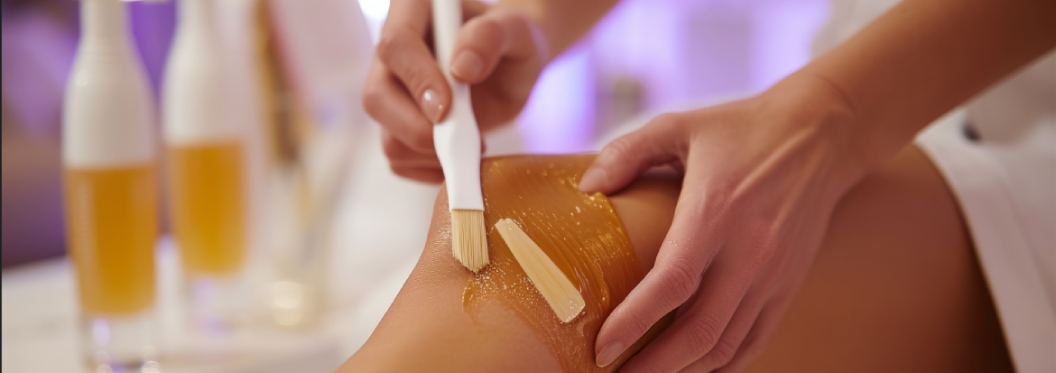When it comes to hair removal, sensitive skin demands extra loving care. Choosing the hair removal method that causes the least irritation, redness, or discomfort while still giving smooth and lasting results is essential. Waxing and sugaring are great options for hair removal that pull the hair out at the root, with differences, however, in their compositions, ways of application, and interaction with human skin, which are important considerations for somebody with sensitive skin.
This article compares the two techniques, especially regarding their effects on sensitive skin. It puts both practices into perspective so that readers might be able to judge for themselves in terms of skin sensitivity, pain tolerance, and what their hearts and minds want to see coming from this experience.

Understanding Waxing and Sugaring
Understanding hair removal methods suitable for sensitive skin leads us to the most natural processes at the roots: waxing and sugaring. Although both processes effectively remove hair from the root, they use different materials and have different application procedures. This essential guide will explain how each interacts with sensitive skin and what to expect during treatment.
What is Waxing?
In the process of applying itself to the skin, wax keeps the hair attached in a sticky position. Once hardened, the wax is removed quickly, pulling hair out by the roots. Soft wax and hard wax (which can peel away) are both methods of waxing. Generally, wax is effective and faster for these procedures.
What is Sugaring?
This makes it even more appealing—here, by mixing a natural paste of sugar, lemon juice, and water, users can remove hair. The sugaring paste is applied and used at body temperature, unlike waxing, but it is removed in the opposite direction of hair growth in the area being treated. It’s highly publicized, gentler, and perhaps most suitable for people with sensitive skin and a concern for the environment.
Key Differences Between Waxing and Sugaring for Sensitive Skin
The choice between waxing and sugaring often depends on the formulations, application techniques, and effects on the skin. Sensitive skin types react differently depending on the ingredients and temperature used. Recognizing these key differences helps individuals find the safest method to achieve healthy skin.
Ingredients and Skin Compatibility
Wax supplies on sale usually contain fragrances along with resins and additives, which are often known to cause irritation in people with sensitive skin or allergies. In contrast, sugaring paste mostly consists of just a few natural ingredients that are less likely to cause allergic reactions or inflammation.
Application Temperature
To depilate, wax is heated to its melting point enough to risk burning the skin or increasing sensitivity. The sugar paste is applied at nearly body temperature, making it softer and less harmful to the most delicate skin.
Method of Hair Removal
Each technique of hair removal may cause various pains and irritation to the skin. Thus, waxing removes hair and some superficial layers of skin from different directions to cause trauma, whereas sugaring pulls hair against growth consistently to lessen breakage and irritation.
Benefits and Drawbacks for Sensitive Skin
With each and every product there is a plus and a minus, especially regarding those who have really delicate skin. These are then the factors to be considered and weighed against one another to choose what goes well in balancing effectiveness, skin comfort, and safety.
Waxing Benefits
- Good for removing coarse or thick hair.
- Many reputable kinds of wax are available at salons that suit different skin and hair types.
- Fast and efficient procedure that can cover larger areas in very short periods.
Waxing Drawbacks
- Skin irritation, redness, or allergic reactions occur more often in the skin due to ingredients.
- Skin can be affected by various burns if wax is overheated.
- Considerable follicle inflammation may develop, with some outbreaks of ingrown hairs.
- Remove surface skin cells, which then become dry and begin to peel.
Sugaring Benefits
- Using natural and hypoallergenic ingredients, they lessen irritation.
- Applied at low temperatures, reduces the chances of causing burns.
- Due to the whisker direction causes fewer ingrown hairs.
- Carefully exfoliates without damaging any skin cells.
- A water-soluble paste that washes off easily with water, avoiding the use of harsh chemicals.
Sugaring Drawbacks
- Sometimes more care and skill may be necessary in its application.
- Less effective on hair that is very coarse and short as compared to waxing.
- Less available in some areas as compared to waxing.
Pain and Comfort Considerations
Both sugaring and waxing remove hair from the root, which naturally involves some pain. According to testimonials from those with sensitive skin, sugaring reduces pain compared to the waxing process. This is mainly because sugar doesn’t adhere to the skin as much and removes hair in the opposite direction of growth, making it gentler on the hair follicles and surrounding skin. More pulling on the skin, especially with strip wax, can cause more discomfort and make the process less comfortable. Additionally, the higher temperature of wax can cause a sensation of burning or stinging.
Aftercare and Skin Recovery
However, it is very sensitive in hair removal; it may still negatively affect the skin. For this reason, diligent aftercare is unquestionably essential regardless of the method used. When waxing or sugaring, the skin may become red, moist, or even dry; however, these effects are much milder and resolve more quickly with sugaring. Applying soothing agents like aloe vera gel or fragrance-free moisturizers also helps with healing for both methods. Avoiding sun exposure, hot showers, and tight clothing immediately after hair removal can reduce irritation. With regular exfoliation after a few days, you can help prevent ingrown hairs, but this should be done gently to avoid damaging sensitive skin.
Summary
Some hair removal methods like waxing and sugaring are very effective but can be harsh on sensitive skin. The natural ingredients in sugaring work at cold temperatures and through gentle techniques; therefore, it is the best choice for those with reactive or sensitive skin. Sugaring reduces irritation, lowers the risk of hairs being pulled into the skin, and is generally less painful than waxing.
Waxing remains a popular and accessible option, especially for larger or heavier areas of hair, but it can cause more skin irritation if proper techniques and aftercare are not followed, particularly on sensitive skin. Ultimately, choosing the right method depends on skin type, pain tolerance, and hair type. Consulting with an experienced esthetician or skincare specialist can help individuals with sensitive skin find the most suitable hair removal approach.

